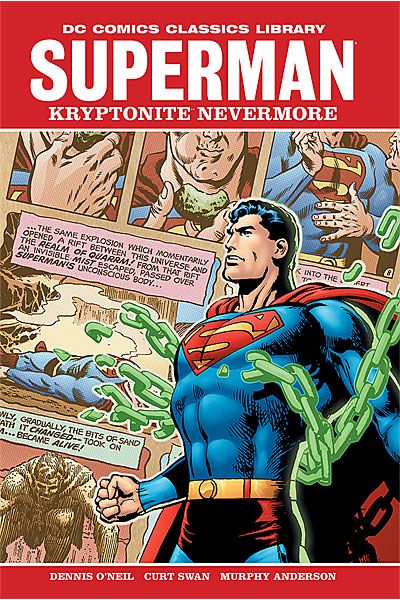When John Byrne came in to revamp Superman in the 1980s, he took a familiar approach: depower him, make him less god-like, and, thus, give him back some semblance of humanity.
After all, the character started as a high-leaping strongman who enforced New Deal policies with his fists.
I say it was a "familiar approach" not just because the original Siegel and Shuster tales featured a Man of Steel who was considerably un-god-like, but because Byrne certainly wasn't the first writer to step foot in Metropolis and say, "this guy with the 'S'? We need to knock him down to a more approachable level."
Denny O'Neil did the same thing with the character over a decade earlier, and this DC Comics Classics Library edition of O'Neil's run on "Superman" reprints the saga of the de-powered Superman. The Superman who could eat kryptonite for breakfast (he is literally seen chomping on the green rocks at one point in the story), and, yet, was less powerful than he had been in decades. While Jack Kirby was crafting cosmic stories over in "Jimmy Olsen," Denny O'Neil was writing about a Superman who was more man than super -- one who made mistakes, one who could suffer a bit. One who couldn't just fly out into space and punch the sun. One who couldn't turn back time and make things all right.
His method for depowering Superman involved an explosion at a kryptonite power plant (which occurs just two pages into the first story reprinted in this slightly-too-expensive hardcover edition), and a being from the Realm of Quarrm. This being -- a creature who becomes a sand-doppelganger of Superman, with half his powers -- is a recurring character throughout this volume. It's the most effective thing about this book, actually, the way O'Neil weaves this larger plot of Superman vs. Sand Superman (or Superman vs. himself, the man vs. the powers) while still structuring each issue episodically. Throughout this book Superman battles natural disasters and strange creatures (like aliens disguised as angels and devils, or Asian statues come to life), but the overarching plot is that of the mysterious Sand Superman -- what he wants and what will happen. It builds to a dramatic climax and resolution by the end of the volume.
O'Neil also completely avoids many of the traditional Superman trappings. The Fortress of Solitude appears briefly, and Lois Lane and Jimmy Olsen are in the background, but we never see much of the Silver Age Superman tropes, like Krypto, or Supergirl, or the Legion of Super-Heroes, and we never see any of his classic villains. No Brainiac. No Luthor. No Mr. Mxyzptlk. Just Superman struggling with his lesser powers and newer DC characters like I Ching (from the mod Wonder Woman comics of the time) coming in with some New Agey help.
Three things make "Kryptonite Nevermore" into a good collection. First of all, as I mentioned, the way O'Neil weaves the Sand Superman uber-plot throughout a year's worth of episodic stories really works wonderfully. Second, for a story that humanizes Superman, it's one that's incredibly bizarre. Superman may be a little less powerful, but these are not down-to-Earth tales. They are weird and quirky and engaging. And third, and this is a pretty big deal, these stories are all drawn by the Super-Team extraordinaire of Curt Swan and Murphy Anderson. The "Swanderson" team did so many Superman comics in the Silver and Bronze Ages that it's easy to take them for granted. But they are perfect for a story about a more human Superman, and perfect at making all the weirdness seem "real."
$40 is kind of steep for less than 200 pages of Bronze Age reprints -- though the stories aren't retouched or recolored, which is a good thing, because you can experience them the way they originally looked, unfiltered, not traced by digital hands -- but this is one of the most satisfying single volumes of Superman reprints available. Superman is a great character, maybe the greatest character, but he doesn't have a whole lot of single volume collections that work as a self-contained, satisfying whole beyond "All-Star Superman" volumes 1 and 2. This, though, is an exception. A good one.

